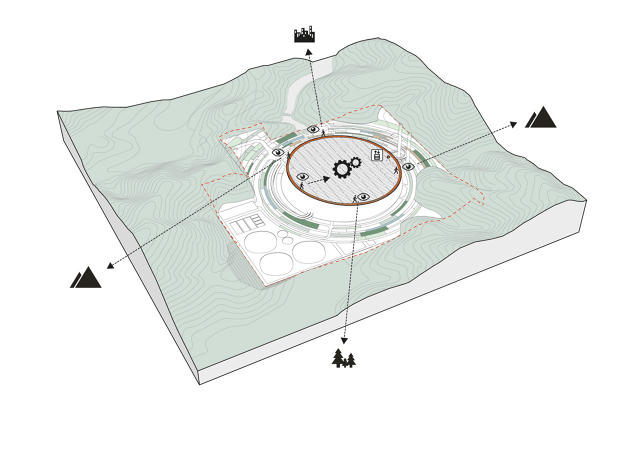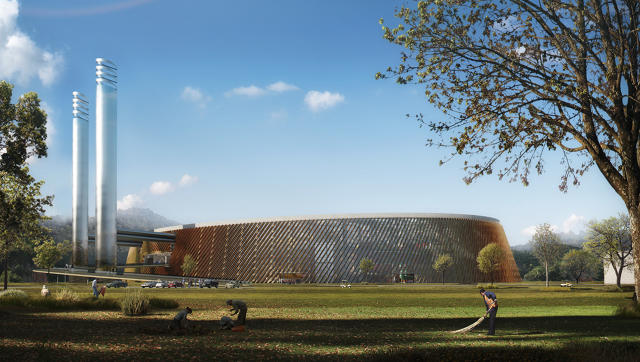this massive Waste-To-vitality Plant would be the greatest on the earth
As cities figure out methods to handle growing piles of trash, they may be taking two paths. Some, like San Francisco, are aiming for zero waste—composting and recycling the whole lot that would possibly have otherwise gone to a landfill. Others are burning rubbish to show it into electrical energy.
In 2020, the same year that San Francisco hopes to change into a 0-waste city, the chinese megacity of Shenzhen will open the world’s greatest waste-to-power plant, stretching virtually a mile across and burning 5,000 tonnes of trash day by day.
the brand new incinerator is one in all 300 waste-to-power plants that the chinese language executive plans to construct over the subsequent three years to lend a hand offset the united states’s all of a sudden increasing dumps. What makes this plant completely different—along with its huge dimension, and sleek design—is the fact that it doubles as a customer center. A public path winds across the circular plant, explaining each and every step of the incineration process, before ending up on the sun panel-topped roof.
“The waste problem is all about schooling—and experiencing the scale of the challenge is a part of that education course of,” says Chris Hardie, companion at Schmidt Hammer Lassen Architects, which received a contest, along with Gottlieb Paludan Architects, for the design of the new plant.

“call to mind it like smoking in the 1950s and Sixties—everyone smoked,” he says. “It used to be only unless a civilization was trained on how much it was once polluting our personal bodies did we dramatically cease. Waste is an identical. in the event you don’t realize the damage it is doing, why cease developing waste?”
In China, most waste presently goes to landfills or unlawful dumps—piles of trash so large that they may be able to if truth be told be dangerous, just like the landfill in Shenzhen that collapsed in December and killed dozens of people nearby. it can be an area downside, but additionally a local weather downside, as a result of landfills emit robust greenhouse gases as garbage rots away.

Incinerating trash additionally pollutes, but a state of the art plant like the one deliberate for Shenzhen can dramatically scale back pollution compared to a city dump. “Burning waste naturally creates pollution, mainly carbon dioxide—something within the area of 1 metric ton of CO2 per metric ton of waste,” says Hardie. “this does not sound nice needless to say, however when you examine it to striking the waste to landfill, one metric ton of waste will ultimately produce somewhere within the region of 60 cubic meters of methane because it decomposes—and this has greater than twice the terrible effect on global warming.”

because the vegetation runs, it may generate some electricity for the town, though incineration shouldn’t be a major supply of energy (and the plant itself runs on solar power, due to 44,000 sq. meters of sunlight panels on the roof). How much energy it creates relies on the roughly trash within—something to be able to trade over time. the better trash is sorted and recycled sooner than the rest’s sent to the plant, the extra effectively the plant can run. ultimately, town will still need to scale back rubbish.
“Waste-to-vitality vegetation usually are not an vitality answer,” says Hardie. “they’re a method of dealing with waste and using this process to generate electrical energy as a byproduct of the process. Cities have to maneuver in opposition to extra recycling and decreasing their waste needless to say—and of course growing more sources of renewable energy. that’s sort of the purpose we are making through proposing this be the primary waste-to-vitality plant that has a renewable portion of it.”
All photography courtesy of Schmidt Hammer Lassen
<img alt="
In 2020, the chinese city Shenzhen will open the sector’s greatest waste-to-energy plant.
” src=”http://b.fastcompany.net/multisite_files/fastcompany/imagecache/slideshow_large/slideshow/2016/02/3056526-slide-s-9-this-large-waste-to-vitality-plant-will-be-the.jpg”>
<img alt="
it’s going to stretch virtually a mile across and burn 5,000 tonnes of trash every day.
” src=”http://a.fastcompany.web/multisite_files/fastcompany/imagecache/slideshow_large/slideshow/2016/02/3056526-slide-s-eight-this-massive-waste-to-energy-plant-will-be-the.jpg”>
<img alt="
it is certainly one of 300 waste-to-energy plants deliberate over the next three years to offset the u . s . a .’s unexpectedly-expanding dumps.
” src=”http://b.fastcompany.web/multisite_files/fastcompany/imagecache/slideshow_large/slideshow/2016/02/3056526-slide-s-7-this-large-waste-to-energy-plant-will-be-the.jpg”>
<img alt="
What makes this plant completely different—along with its large size, and graceful design—is the fact that it doubles as a visitor middle.
” src=”http://c.fastcompany.internet/multisite_files/fastcompany/imagecache/slideshow_large/slideshow/2016/02/3056526-slide-s-6-this-large-waste-to-energy-plant-will-be-the.jpg”>
<img alt="
A public course winds across the round plant, explaining every step of the incineration course of, ahead of ending up on the sun panel-topped roof.
” src=”http://d.fastcompany.internet/multisite_files/fastcompany/imagecache/slideshow_large/slideshow/2016/02/3056526-slide-s-5-this-huge-waste-to-power-plant-will-be-the.jpg”>
<img alt="
In China, most waste at the moment goes to landfills or illegal dumps—piles of trash so huge that they may be able to in truth be dangerous.
” src=”http://a.fastcompany.net/multisite_files/fastcompany/imagecache/slideshow_large/slideshow/2016/02/3056526-slide-s-four-this-huge-waste-to-vitality-plant-will-be-the.jpg”>
<img alt="
it can be an area drawback, but additionally a local weather downside, as a result of landfills emit potent greenhouse gases as rubbish rots away.
” src=”http://d.fastcompany.net/multisite_files/fastcompany/imagecache/slideshow_large/slideshow/2016/02/3056526-slide-s-three-this-massive-waste-to-vitality-plant-will-be-the.jpg”>
<img alt="
Incinerating trash also pollutes, however a state-of-the-art plant just like the one planned for Shenzhen can dramatically scale back air pollution compared to a city dump.
” src=”http://c.fastcompany.net/multisite_files/fastcompany/imagecache/slideshow_large/slideshow/2016/02/3056526-slide-s-2-this-large-waste-to-power-plant-will-be-the.jpg”>
<img alt="
because the vegetation runs, it could possibly generate some electricity for town, though incineration is not an enormous supply of energy.
” src=”http://d.fastcompany.web/multisite_files/fastcompany/imagecache/slideshow_large/slideshow/2016/02/3056526-slide-s-1-this-large-waste-to-energy-plant-will-be-the.jpg”>
quick company , read Full Story
(20)














